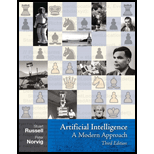
Concept explainers
Suppose the agent has progressed to the point shown in Figure 7.4(a), page 239, having perceived nothing in [1,1], a breeze in [2,1], and a stench in [1,2], and is now concerned with the contents of [1,3], [2,2], and [3,1]. Each of these can contain a pit, and at most one can contain a wumpus. Following the example of Figure 7.5, construct the set of possible worlds. (You should find 32 of them.) Mark the worlds in which the KB is true and those in which
each of the following sentences is true:
α2 = “There is no pit in [2,2].”
α3 = “There is a wumpus in [1,3].”
Hence show that KB |= α2 and KB |= α3.
Explanation of Solution
True statement
- There are eight possible combinations in the three squares.
- There are four possibilities for the wumpus location.
- KB |= α2 is true because in every line KB is true and also has α2 true.
- This is similar in the case of α3.
Want to see more full solutions like this?
Chapter 7 Solutions
Artificial Intelligence: A Modern Approach
Additional Engineering Textbook Solutions
Degarmo's Materials And Processes In Manufacturing
Mechanics of Materials (10th Edition)
Starting Out with C++ from Control Structures to Objects (9th Edition)
Starting Out With Visual Basic (8th Edition)
Concepts Of Programming Languages
INTERNATIONAL EDITION---Engineering Mechanics: Statics, 14th edition (SI unit)
- Write the following in C# WinForms. Create a poacher class that has random x and y values when created, private set function for x and y values. Implement a function in the main menu that makes the poacher move into random direction. The movement should seem seamless. The poacher can be drew by the following in the main menu. e.Graphics.DrawImage(poacherImage, poacher.X, poacherY, tileSize, tileSize); Write the following in C# WinForms. Create a poacher class that has random x and y values when created, private set function for x and y values. Implement a function in the main menu that makes the poacher move into random direction. The movement should seem seamless. The poacher can be drew by the following in the main menu. e.Graphics.DrawImage(poacherImage, poacher.X, poacherY, tileSize, tileSize);arrow_forwardWrite the following in C# WinForms. Create a poacher class that has random x and y values when created, private set function for x and y values. Implement a function in the main menu that makes the poacher move into random direction. The movement should seem seamless. The poacher can be drew by the following in the main menu. e.Graphics.DrawImage(poacherImage, poacher.X, poacherY, tileSize, tileSize);arrow_forwardWrite the following in C# WinForms. Create a poacher class that has random x and y values when created, private set function for x and y values. Implement a function in the main menu that makes the poacher move into random direction. The movement should seem seamless. The picture of the poacher is drew by e.Graphics.DrawImage(poacherImage, poacher.X, poacher.Y, tileSize, tileSize);arrow_forward
- Create a poacher class that has random x and y values when created, private set function for x and y values, and implement a function in the main menu that makes the poacher move into random direction. The movement should seem seamless. Write it in C# WinFormsarrow_forwardHi, please solve this trying to follow this criteria. (use Keil) Abstract describing the requirements and goals of the assignment. List file with no errors or warnings. Brief description of your implementation design and code. Debugging screen shots for different scenarios with your reference and comments. Conclusionarrow_forwardCan you solve using iterative expansionarrow_forward
- Write a C program using embedded assembler with a function to convert a digit (0 – 15) to the corresponding ASCII character representing the value in hexadecimal. For numbers 0 – 9, the output will be the characters '0' – '9', for numbers 10 – 15 the characters 'A' – 'F'. The entire core of the program must be written in symbolic instruction language; arrays may not be used. You may only use C to print the result. Tip: This piece of C program will do the same thing: character = number < 10 ? number + '0' : number + 55; As a basis, you can use this program again , which increments a variable. Just replace the INC instruction with ADD and add a test (CMP) with some conditional jump.arrow_forwardAnswer the question fully and accurately by providing the required files(Java Code, Two output files and written answers to questions 1-3 in a word document)meaning question 1 to 3 also provide correct answers for those questions.(note: this quetion is not graded).arrow_forward.NET Interactive Solving Sudoku using Grover's Algorithm We will now solve a simple problem using Grover's algorithm, for which we do not necessarily know the solution beforehand. Our problem is a 2x2 binary sudoku, which in our case has two simple rules: •No column may contain the same value twice •No row may contain the same value twice If we assign each square in our sudoku to a variable like so: 1 V V₁ V3 V2 we want our circuit to output a solution to this sudoku. Note that, while this approach of using Grover's algorithm to solve this problem is not practical (you can probably find the solution in your head!), the purpose of this example is to demonstrate the conversion of classical decision problems into oracles for Grover's algorithm. Turning the Problem into a Circuit We want to create an oracle that will help us solve this problem, and we will start by creating a circuit that identifies a correct solution, we simply need to create a classical function on a quantum circuit that…arrow_forward
 Operations Research : Applications and AlgorithmsComputer ScienceISBN:9780534380588Author:Wayne L. WinstonPublisher:Brooks Cole
Operations Research : Applications and AlgorithmsComputer ScienceISBN:9780534380588Author:Wayne L. WinstonPublisher:Brooks Cole C++ for Engineers and ScientistsComputer ScienceISBN:9781133187844Author:Bronson, Gary J.Publisher:Course Technology Ptr
C++ for Engineers and ScientistsComputer ScienceISBN:9781133187844Author:Bronson, Gary J.Publisher:Course Technology Ptr C++ Programming: From Problem Analysis to Program...Computer ScienceISBN:9781337102087Author:D. S. MalikPublisher:Cengage Learning
C++ Programming: From Problem Analysis to Program...Computer ScienceISBN:9781337102087Author:D. S. MalikPublisher:Cengage Learning LINUX+ AND LPIC-1 GDE.TO LINUX CERTIF.Computer ScienceISBN:9781337569798Author:ECKERTPublisher:CENGAGE L
LINUX+ AND LPIC-1 GDE.TO LINUX CERTIF.Computer ScienceISBN:9781337569798Author:ECKERTPublisher:CENGAGE L Principles of Information Systems (MindTap Course...Computer ScienceISBN:9781285867168Author:Ralph Stair, George ReynoldsPublisher:Cengage LearningProgramming Logic & Design ComprehensiveComputer ScienceISBN:9781337669405Author:FARRELLPublisher:Cengage
Principles of Information Systems (MindTap Course...Computer ScienceISBN:9781285867168Author:Ralph Stair, George ReynoldsPublisher:Cengage LearningProgramming Logic & Design ComprehensiveComputer ScienceISBN:9781337669405Author:FARRELLPublisher:Cengage





